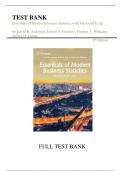TEST BANK Essentials of Modern Business Statistics with Microsoft Excel by David R. Anderson , Dennis J. Sweene y, Thomas A. Williams , Jeffrey D. Camm 8th Edition FULL TEST BANK Chapter 1 Data and Statistics Learning Objectives 1. Obtain an appreciation for the breadth of statistical applications in business and economics. 2. Understand the meaning of the terms elements, variables, and observations as they are used in statistics. 3. Obtain an understanding of the difference between categorical, quantitative, cross -sectional, and time series data. 4. Learn about the sources of data for statistical analysis both internal and external to the firm. 5. Be aware of how errors can arise in data. 6. Know the meaning of descriptive statistics and statistical inference. 7. Be able to distinguish between a population and a sample. 8. Understand the role a sample plays in making statistical inferences about the population. 9. Know the meaning of the terms analytics, big data and data mining. 10. Be aware of ethical guidelines for statistical practice. 4 - 2 Solutions: 1. Statistics can be referred to as numerical facts. In a broader sense, statistics is the field of study dealing with the collection, analysis, presentation, and interpretation of data. 2. a. The ten elements are the ten tablet computers. b. Five variables: Cost ($), Operating System, Display Size (inches), Battery Life (hours), CPU Manufacturer c. Categorical variables: Operating System and CPU Manufacturer Quantitative variables: Cost ($), Display Size (inches), and Battery Life (hours) d. Variable Measurement Scale Cost ($) Ratio Operating System Nominal Display Size (inches) Ratio Battery Life (hours) Ratio CPU Manufacturer Nominal 3. a. Average cost = 5829/10 = $582.90 b. Average cost with a Windows operating system = 3616/5 = $723.20 Average cost with an Android operating system = 1714/4 = $428.5 The average cost with a Windows operating system is much higher. c. 2 of 10 or 20% use a CPU manufactured by TI OMAP. d. 4 of 10 or 40% use an Android operating system. 4. a. There are eight elements in this data set; each element corresponds to one of the eight models of cordless telephones. b. Categorical variables: Voice Quality and Handset on Base Quantitative variables: Price, Overall Score, and Talk Time c. Price – ratio measurement Overall Score – interval measurement Voice Quality – ordinal measurement Handset on Base – nominal measurement Talk Time – ratio measurement 5. a. Average Price = 545/8 = $68.13 b. Average Talk Time = 71/8 = 8.875 hours c. Percentage rated Excellent: 2 of 8 2/8 = .25, or 25%




